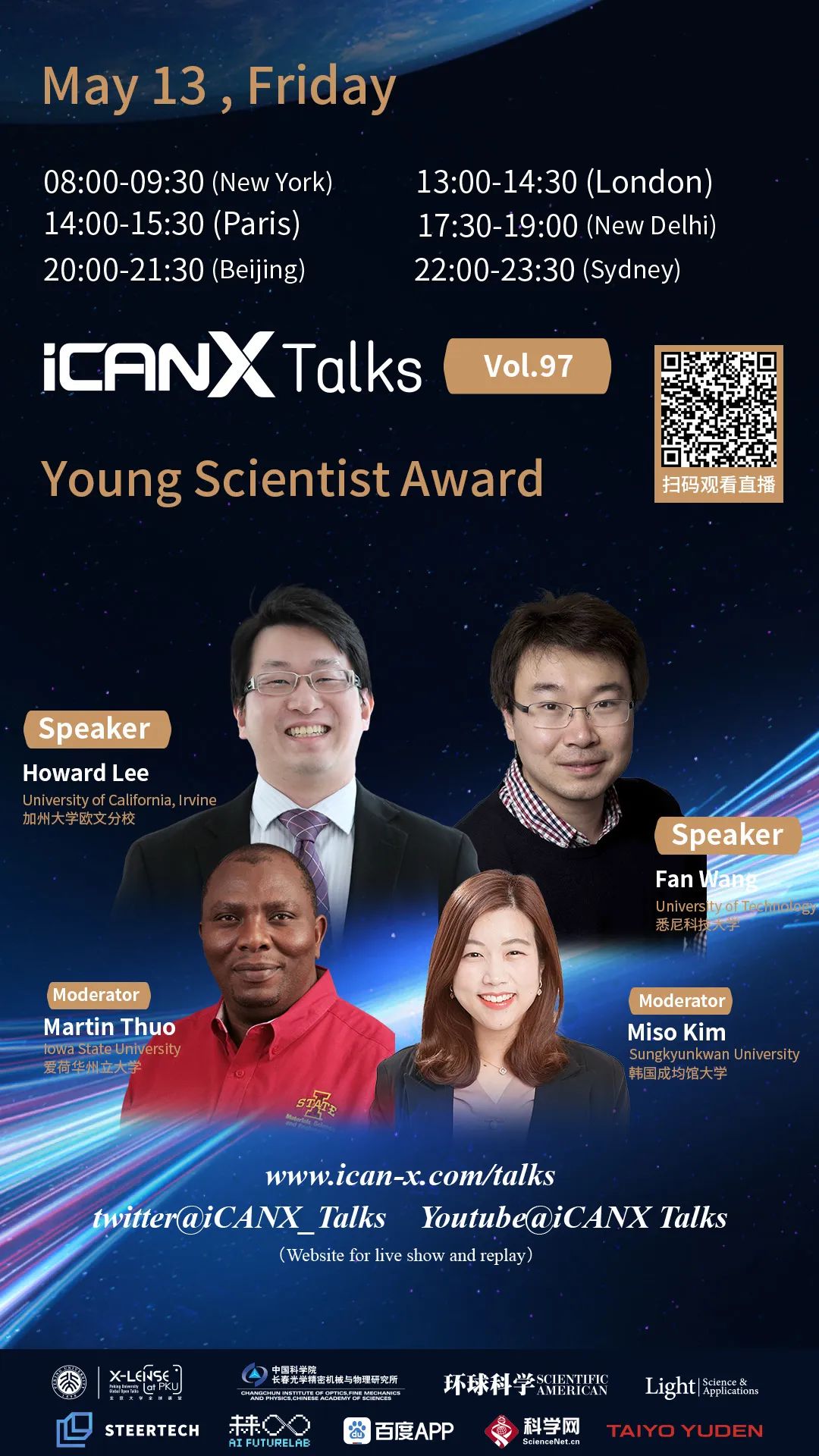[Lecture] iCANX Talks Vol. 97
May. 13, 2022
Theme:
Active Meta-Optics and “Meta”-Optical Fibers
Lanthanide doped Nanoparticles for Biophotonics Applications
Speaker:
Howard (Ho Wai) Lee, University of California, Irvine
Fan Wang, University of Technology, Sydney
Moderator:
Martin Thuo, Iowa State University
Miso Kim, Sungkyunkwan University
Time: 20:00-21:00, May 13, 2022 (GMT+8)
Venue: Scan the QR code
Abstract:
Lecture 1
Controlling the flow of light is fundamental to optical applications. With advances in nanofabrication capabilities and new theoretical concepts, ground-breaking platforms for the nanoscale manipulation of light have been demonstrated in recent years. This include ultrathin optical metasurfaces which offer unique optical features such as sub-wavelength optical confinement, enhanced optical nonlinear/quantum properties, and advanced wavefront shaping for emerging optical imaging, bio/optical sensing, medical, and communication applications.
This talk will review our research efforts on electrically tunable meta-optics for developing new optical applications. I will present our recent advances on the use of transparent conducting oxide materials to demonstrate gate-tunable ultrathin optical metasurfaces that can tune the optical phase and amplitude for light steering and nonlinear/quantum emission control. I will then discuss our study on a new type of “meta”-optical fiber which merges the sciences of optical metasurfaces and optical fibers. The development of the ultrathin optical fiber metalens and color filter for potential laser surgery, medical imaging endoscope applications, and novel in-fiber laser will be discussed. These advanced “meta”-optical fibers open the path to revolutionary in-fiber lasers/spectroscopies, optical imaging/sensing, and optical/quantum communication applications.
Lecture 2
Biophotonics, including super-resolution imaging, optical tweezers and nanoscale sensing, are powerful and essential tools for next-generation subcellular biophysics research. This talk will introduce a series of newly developed biophotonics technologies based on the nonlinearity optical response of rare-earth element doped nanoparticles. The technologies of deep-tissue super-resolution imaging, including multi-photon near-infrared emission saturation nanoscopy, NIR Bessel-beam emission saturation nanoscopy, Upconversion Nonlinear Structured Illumination Microscopy, and Heterochromatic Nonlinear Optical Responses Nanoscopy will be reported. NIRES has achieved a resolution of sub-50 nm in imaging a single nanoparticle through 93 μm mouse liver tissue. Furthermore, we have harnessed the resonance of highly doping lanthanide ions in NaYF4 nanocrystals to enhance the permittivity of nanocrystals, leading to enhanced optical trapping forces by orders of magnitude, more than 30 times stronger than the reported value for traditional gold nanoparticles, bypassing the trapping requirement of refractive index mismatch. In addition, we have developed a photonic substrate that enables the self-interference of nanoparticles. We further harnessed this self-interference effect to generate position-sensitive patterns for obtaining the axial localisation of particles with a sub-nanometre resolution and ultra-high imaging speed (30 μm by 30 μm, 50 Hz).
Biography:
Lecturer 1
Howard Lee is currently an Associate Professor in the Department of Physics and Astronomy at UC Irvine. Before joining UCI, he was an Associated Professor in the Department of Physics at Baylor University and IQSE Fellow and visiting professor in the Institute for Quantum Science and Engineering (IQSE) at TexasA&M. He was a Postdoctoral Fellow at the Caltech, working with Prof. Harry Atwater in active plasmonics/metasurfaces. He received his PhD in Physics from the Max Planck Institute for the Science of Light in Germany in 2012 under the supervision of Prof. Philip Russell. His current research focuses on active linear, nonlinear, and quantum plasmonic/metasurface/zero-index optics, quantum biophotonics and imaging, “meta”-fiber optics, and hybrid photonic-plasmonic on-chip optical devices. His work on nano-optics, plasmonics, and photonic crystal fibers has led to 35 journal publications in various journals, such as Science, Nano Letters, Advanced Materials, and ACS Photonics, as well as 50 invited talks and 130 conference papers. Dr. Lee is a recipient of a 2021 iCANX Young Scientist Award, 2021 Finalist of Rising Stars of Light, 2020 SPIE Rising Researcher, a 2020 Baylor Outstanding Professor Award, a 2019 DARPA Director’s Fellowship, a 2019 IEEE OGC Young Scientist Award, a 2018 NSF CAREER Award, a 2017 DARPA Young Faculty Award, a 2018 OSA Ambassador, a 2017 APS Robert S. Hyer Award, a 2018 Baylor Young Investigator Award, a 2016 Baylor Proposal Development Award, and a 2012 Croucher Postdoctoral Fellowship.
He organized more than 15 technical sessions in nanophotonics/metasurfaces in international conferences (CLEO, META, PQE, MRS) and serves as Lead Symposium Organizer for plasmonic/metasurface symposiums at 2019-2022 MRS Fall Meeting and 2020-2022 MRS Spring Meeting. He is a Founding Associate Editor for OSA Continuum and Associate Editor for Nature Scientific Reports and Photonics journals.
Lecturer 2
Dr Fan Wang is an ARC DECRA fellow, leading the biophotonics research group at UTS. Dr Wang has extensive expertise in optoelectronics, biophotonics, and nanomaterials. He also has expertise in biophotonics application of nanomaterials, including super-resolution microscopy, optical tweezers, single nanoparticle tracking and sensing. Dr Wang has published over 65 peer-reviewed journal articles (include 13 Nature series journals) with an h-index of 30 (Google Scholar) and over 3802 citations. As the first/corresponding author, he has published in Nature Nanotechnology, Nature Communications×2, Nano Letters×5, Advanced Materials, Optica, Light: Science & Application, and Small. Dr. Wang obtained his Ph.D. from the University of New South Wales in Australia in 2014. From 2013 to 2015, he worked as a Postdoctoral Research Fellow in Prof. Jagadish’s group at the Australian National University studying semiconductor nanowires. Since 2015, Dr. Wang joined the ARC centre of excellence for nanoscale biophotonics at Macquarie University, and he joined Prof. Dayong Jin’s group in UTS to lead the biophotonics team. In 2019, Dr Wang was awarded the UTS Chancellor’s Postdoctoral Research Fellowship (2019) to establish his biophotonics research team. In 2020, he was also awarded the DECRA (2020) to conduct his biological laser cooling technology research, and he joined the School of Electrical and Data Engineering as a lecturer to establish his nano-optoelectronics group. In 2021, he was awarded the David Syme research prize due to his biophotonics research.
Source: iCANX

